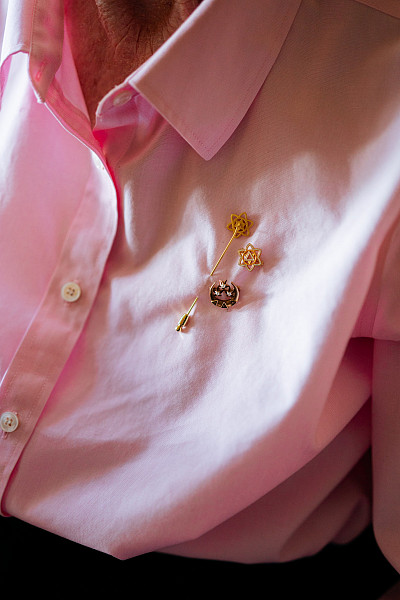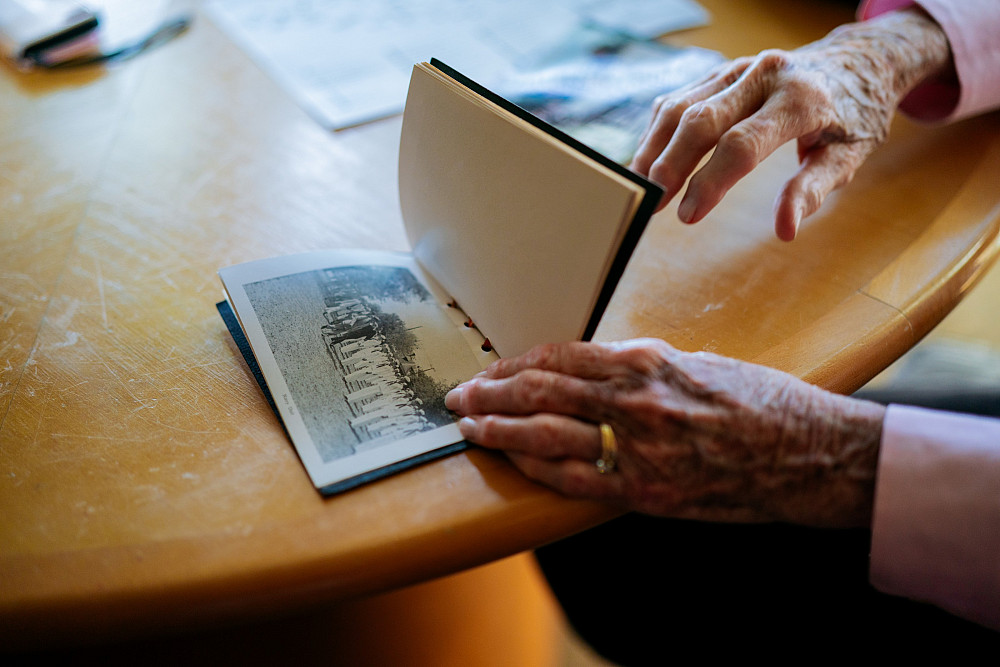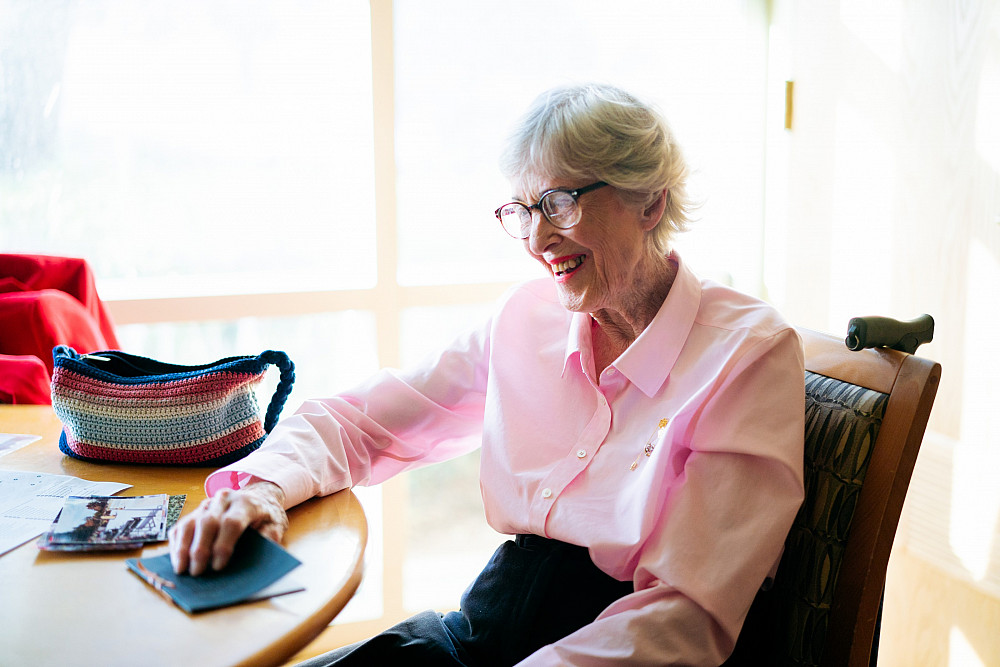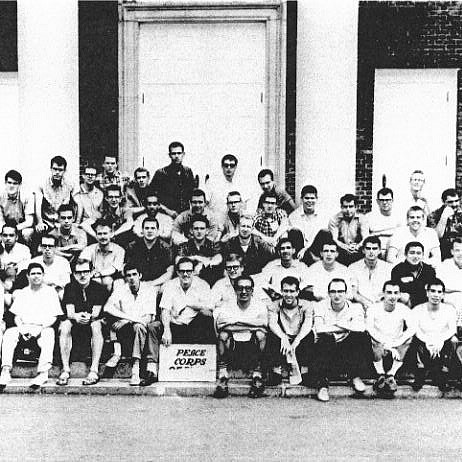News
A Life Well Lived
March 19, 2020
March 19, 2020
Open gallery

When Julia Byrom Whatley ’44 arrived on campus for Charter Day earlier this spring, she was quick to point out her lapel pins. “This moon pin was my original Tri Delta pin,” she says in her lilting Texas accent, pointing proudly to the pearl-adorned stars and crescent that serve as the international sorority’s initiation badge. “That was from 1942. And this one, the other little one,” she adds, displaying a pin that resembles layered triangles within the petals of a flower, “is my 50th Tri Delta anniversary.”

Credit: Carlos BarronBorn in Austin and raised in Georgetown, Whatley has much more than her Tri Delta membership to be proud of. Having earned her B.A. in English from Southwestern just shy of her 20th birthday, she enlisted in the Coast Guard Women’s Reserve soon after graduation, serving two years during the end of World War II. The G.I. Bill allowed her to complete further coursework at SU, and after she and her husband, Calvin Whatley, married and spent several years as educators in Texas schools (Julia as a teacher, Calvin as a teacher and principal), the couple moved to Europe in 1958 to teach in France and Germany as civil servants for the U.S. Army for four years. After completing their careers in education back in the States in 1984, the pair retired to Temple, just six miles east of Eddy, where they managed a 500-acre farm that used to belong to Calvin’s grandfather.
Today, at 95 years young, the Southwestern alumna is still overseeing that farm (“we have 14 cows,” she clarifies, “[but] we used to have 70 or 80”), still drives a car, and still maintains her magnetic Southern charm and fiery spirit.
“I don’t know why I’ve lived so long,” Whatley laughs, “but my cute husband and I, we just had a good time… . My husband and I have had the best life together.”
Southwestern memories
When asked about what she remembers most about her time at Southwestern University, Whatley says with a twinkle in her eye, “I guess those Wednesday night dances—I think that was the best part. We just knew everybody, and we all knew everybody’s names.”
“I guess those Wednesday night dances—I think that was the best part. We just knew everybody, and we all knew everybody’s names.”
She recalls loving her English and history courses but hating her economics classes. She had a “good friend” in John Tower ’48, who would later become a U.S. senator, but in their younger years, Tower would call her house on College Avenue in the evening, looking to grab a beer with her brother. And she says that the U.S. Navy V-12 Unit that trained on campus in the early 1940s meant that “suddenly we had 360 or so boys on campus.” The trainees would train by the gym, but they would also attend dances on Wednesdays, Fridays, and Saturdays. “The sailors were just darling,” Whatleys says, a flirty giggle still present in her voice.
SPARS
Whatley’s father had served in the military in World War I, and she and her younger brother, James Stiles Byrom Jr. ’50, were expected to follow in his footsteps. Whatley would choose the U.S. Coast Guard Women’s Reserve, or SPARS—the acronym derives from the Coast Guard’s Latin motto and English translation, Semper Paratus ‘Always Ready’—whereas Byrom would enlist in the U.S. Navy as soon as he graduated from Georgetown High School in 1944.
Whatley spent six weeks in basic training in Palm Beach, Florida, followed by four months of more specialized training as a yeoman, focusing on secretarial and clerical duties. She was assigned for 18 months to a post at Coast Guard headquarters in Washington, DC, where she was promoted to Yeoman 2nd Class. But Whatley confirms that her role in the military was not so much engaging in war but rather providing support services for her male counterparts and their commanders—as the tagline on one SPARS recruitment poster touted, “Free a man for active duty!” She recalls once being asked, “Did you get a gun when you were in basic?” to which Whatley says she responded, “A gun? We had typing fingers!”

Studying and teaching abroad
After two years of service in SPARS, Whatley returned to Texas, where she would attend classes at Southwestern and reconnect with a fellow young veteran whom she had first met at the age of 13 during one of the many summers he would spend in Georgetown: Dallas native Calvin Whatley. Having served as a sergeant in the U.S. Army in the Pacific theater of WWII, Calvin had attended Southern Methodist University. He and Whatley married in Georgetown in 1948. The G.I. Bill afforded them a honeymoon south of the border. “I got $75, and Calvin got $125,” Whatley recollects, “and nobody else around had that much money!” They spent several weeks as newlyweds in Mexico City, where they took classes at the University of Mexico.
After earning their master’s degrees at East Texas State Teachers College, the Whatleys would teach and Calvin would serve as principal at several Texas schools for the next eight years. They then moved to Europe, where Julia continued teaching and Calvin worked as an administrator at schools for the children of U.S. Army enlisted personnel and at the U.S. Embassy in Bonn, Germany. Whatley remembers that students at the Embassy came from 21 different nations, and she sometimes taught three elementary-school grades—as many as 70 students—in a single classroom at once; Calvin, meanwhile, had to wrangle five grades simultaneously.
Nevertheless, she and her husband loved teaching the children, and their students responded in kind. “Instead of just staying one year,” she remarks, “we stayed four years because we were having such a good time!” Of course, it didn’t hurt that teaching overseas paid better than in the States, and “things were much cheaper overseas!” she laughs.

A working retirement
After returning to the U.S., the Whatleys settled in Temple, Texas, where they continued their education careers until the mid-1980s. After three decades of leading K–12 classrooms, grading papers, and working with parents, the couple knew it was time to retire from education because the advent of standardized tests heralded an undesirable change in the profession of teaching.
They devoted their time to managing the 500-acre farm in Falls County that had been in the Whatley family since 1874 and had been the couple’s residence since 1974. Whatley admits that farming is hard work, even with the “monstrous machines” in use today. But the couple were devoted to their efforts, planting live oaks, implementing conservation strategies, and even becoming caretakers of the Blevins cemetery, which lies a mile from their house. “You have to come see it!” she says excitedly. “There was nothing in that cemetery, and we’d just go past it all the time, and one day, I said, ‘Calvin, we have to do something with this cemetery.’ Calvin had 11 relatives in that cemetery that he didn’t know.” The Whatleys have successfully helped beautify the grounds over the years.
Julia and Calvin Whatley never had children—“I don’t think I could do that!” she exclaims—so she has handed off farming duties to “two good-looking bachelors.” Her beloved husband of 72 years passed away in February, but she is happily surrounded by loving neighbors, friends, and extended family. She still keeps in touch with many of her students, who help keep her young at heart and in mind. To prospective and current Southwestern students alike, she wisely advises, “Go to school every day, and never skip a class. Don’t worry about raising your hand because you’re too shy. Brag on the teachers, and go tell the teachers that you’re having a good time… . My mother-in-law, Calvin’s mother, told me to do two things: one was [have] a second pair of shoes, and [second was] be very nice to the man who was sweeping the floors. And that’s what I did—all the way.”
















